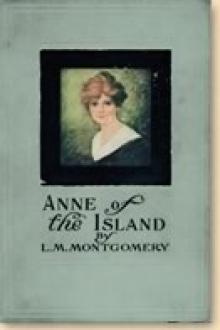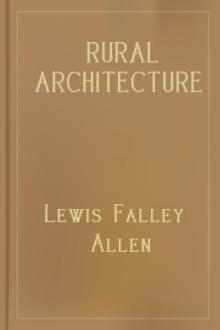A History of Art for Beginners and Students, Clara Erskine Clement Waters [best beach reads .txt] 📗

- Author: Clara Erskine Clement Waters
- Performer: -
Book online «A History of Art for Beginners and Students, Clara Erskine Clement Waters [best beach reads .txt] 📗». Author Clara Erskine Clement Waters
Her mother’s death occurred at Milan, and her father returned to Schwarzenburg. The people about her were so coarse and disagreeable to Angelica that she passed much of her time in the grand forests. At this time she painted frescoes of the Twelve Apostles, copied from the engravings after Piazetta. Her father was not content to remain away from Italy, and they went again to Milan, then to Florence, and at last to Rome. She was now eighteen years old, and found much profit in the friendship of the great scholar Winckelmann, who allowed her to paint his portrait. Angelica visited Naples and Bologna also, and finally Venice, where she met Lady Wentworth, who became her friend, and afterward took her to England.
She had a most brilliant career in London, where her friends were in the highest rank of society. De Rossi described her appearance at this time, and said that she was not very tall, but had a slight, elegant figure. Her complexion was dark and clear, her mouth well formed, her teeth white and even, and all her features good. He speaks of her azure eyes, so placid and bright that their expression had a charm which could not be described. No one felt like criticising her. Other artists paid her many honors, and she was made a member of the Academy of Arts. It has been said that Fuseli, the learned art critic, and Sir Joshua Reynolds, the great artist, both asked her hand in marriage. Some members of the royal family became her friends, and she was at the height of honorable success and of happiness.
It is painful to turn from this bright picture of her life to all the sorrow and darkness which followed it. She made an unhappy marriage, her husband proving to be an adventurer who had assumed a distinguished name. For a time she was crushed by this sorrow; but her friends remained true to her, and she found relief in absolute devotion to her art. For twelve years she supported herself and her father; then his health failed, and it was thought best for him to go to Italy. Angelica was now forty years old, and before leaving England she married Antonio Zucchi, an artist who had long been her friend. He devoted himself to her and to her father with untiring affection, and when the old man died he was happy in the thought that his beloved daughter had so true a friend as Zucchi.
From this time their home was in Rome, where Angelica was the centre of an artistic and literary society of a high order. Among her visitors were such men as Herder and Goethe. The latter wrote of her: “The light and pleasing in form and color, in design and execution, distinguish the numerous works of our artist. No living painter excels her in dignity or in the delicate taste with which she handles the pencil.” She was very industrious, and her life seems to have been divided between two pleasures, her work and the society of her friends, until the death of her husband, which occurred in 1795. She lived twelve years longer, but they were years of great sadness. She made journeys in order to regain her spirits. She visited the scenes of her childhood, and remained some time in Venice with the family of Signor Zucchi.
Even after her last return to Rome she worked as much as her strength would permit, but her life was not long. She was mourned sincerely in Rome; her funeral was attended by the members of the Academy of St. Luke; and her latest works were borne in the procession. She was buried beside her husband in the Church of St. Andrea dei Frati. Her bust was placed in the Pantheon.
Various critics have praised her works in the most liberal manner; others can say nothing good of them. For myself, I cannot find the extreme of praise or blame a just estimate of her. No one can deny the grace of her design, which was also creditably correct. Her portraits were good; her poetical subjects are very pleasing; her historical pictures are not strong; her color was as harmonious and mellow as that of the best Italians, excepting a few of the greatest masters, and in all her pictures there is something which wins for her a certain fondness and praise, even while her faults are plainly seen. Her pictures are to be found in galleries in Rome, Florence, Vienna, Munich, and England; many are also in private collections. She painted several portraits of herself; one in the Uffizi, at Florence, is very pleasing. She represents herself seated in a solitary landscape, with a portfolio in one hand and a pencil in the other. She has an air of perfect unconsciousness, as if she thought of her work only. Her etchings are much valued, and sell for large prices. Many of her pictures were engraved by Bartolozzi, and good prints of them are rare. On one of her pictures she wrote: “I will not attempt to express supernatural things by human inspiration, but wait for that till I reach heaven, if there is painting done there.”
PAINTING IN SPAIN.
Spanish painting had its birth during the reign of Ferdinand and Isabella, and may be said to have been derived from Italy, through the influence of the Italian painters who went to Spain, and the Spanish artists who made their studies in Italy. But in spite of this strong Italian influence Spanish painting has its own characteristics which separate it from all other schools, and give it a high position on its own merits. Antonio del Rincon (1446-1500) was the first Spanish painter of whom we know. If any works of his remain they are portraits of his august sovereigns now in the Cathedral of Granada; but it is probable that these pictures are copies of the originals by Rincon.
Dating the beginning of the Spanish school from the last half of the fifteenth century, it is the third school in Europe as to age, it being about two centuries later than the Italian, and one century later than the Flemish school. Its importance is only exceeded by that of Italy. The distinguishing feature of Spanish art is its gravity, or we may almost say its strictly religious character, for, excepting portraits, there were few pictures of consequence that had not a religious meaning. Some artists were also priests, and, as the officers of the Inquisition appointed inspectors whose duty it was to report for punishment any artist who did not follow the rules of the Inquisition, it is easy to understand that the painters were careful to keep within the rules fixed for them. Whatever flights of imagination one might have in secret, he would scarcely run the risk of being excommunicated from the church, sent into exile for a year, and fined one thousand five hundred ducats for the pleasure of putting his fancies on canvas.
Pacheco, who was an inspector at Seville, published minute rules for the representation of sacred subjects and persons, and other writers did the same. There was a long and grave discussion over the propriety of painting the devil with horns and a tail. It was decided that he should have horns because, according to the legend of St. Theresa, he had horns when he appeared to that saint; and he was allowed to have a tail because it was thought to be a suitable appendage to a fallen angel who had lost his wings. One very strict rule was that the feet of the Virgin Mary should be covered, and nude figures or portions of the figure were strictly forbidden.
Another important influence upon the Spanish artists was their belief that the Virgin Mary and other holy spirits appeared to inspire them and aid them in painting their pictures. In fact, the church was the chief patron of art, and the artist was one of her most valuable teachers. A learned Spanish writer said: “For the ignorant, what master is like painting? They may read their duty in a picture though they may not search for it in books.”
The painters of Spain were divided between the schools of Castile, Seville, and Valencia. That of Castile was founded at Toledo early in the fifteenth century, and was maintained about two hundred years. Claudio Coello was of this school; he died in 1693, and has well been called “the last of the old masters of Spain.”
Alonzo Berreguette (1480-1561), born at Parades de Nava, in Castile, was the most eminent Spanish artist of his time. He is called the Michael Angelo of Spain, because he was painter, sculptor, and architect. He was painter to Philip I. Later he went to Italy, and journeyed from Florence to Rome with Michael Angelo in 1505. He studied in Italy many years. He was appointed painter and sculptor to the Emperor Charles V. Berreguette received four thousand four hundred ducats for the altar in the Church of St. Benito el Real in Valladolid, where he settled. When he was almost eighty years old he went to Toledo to erect a monument in the Hospital of St. John Baptist. He was lodged in the hospital, and died there. He left a large fortune, and was buried with splendid ceremonies at the expense of the emperor.
Luis de Morales (1510-1586) was called “the divine.” He belonged to the school of Castile, and very little is known of his early life. When he was fifty-five years old Philip II. invited him to court. When Morales appeared he was so splendidly dressed that the king was angry, and gave orders that he should be paid a certain sum and dismissed. But the poor painter explained that he had spent all that he had in order to come before the king in a dress befitting Philip’s dignity. Then Philip pardoned him, and allowed him to paint one picture; but as this was not hung in the Escorial, Morales was overcome by mortification, and almost forsook his painting, and fell into great poverty. In 1581 the king saw Morales at Badajoz, in a very different dress from that he had worn at court. The king said: “Morales, you are very old.” “Yes, sire, and very poor,” replied the painter. The king then commanded that he should have two hundred ducats a year from the crown rents with which to buy his dinners. Morales hearing this, exclaimed, “And for supper, sire?” This pleased Philip, and he added one hundred ducats to the pension. The street in Badajoz on which Morales lived bears his name.
Nearly all his pictures were of religious subjects, and on this account he was called “the divine.” He avoided ghastly, painful pictures, and was one of the most spiritual of the artists of Spain. Very few of his pictures are seen out of Spain, and they are rare even there. His masterpiece is “Christ Crowned with Thorns,” in the Queen of Spain’s Gallery at Madrid. In the Louvre is his “Christ Bearing the Cross.” At the sale of the Soult collection his “Way to Calvary” sold for nine hundred and eighty pounds sterling.
Alonso Sanchez Coello (about 1515-1590) was the first great portrait painter of Spain. He was painter-in-ordinary to Philip II., and that monarch was so fond of him that in his letters he called him “my beloved son.” At Madrid the king had a key to a private entrance





Comments (0)